Norwegian Cruise Line Holdings Bundle
How Does Norwegian Cruise Line Navigate the High Seas of Business?
Norwegian Cruise Line Holdings (NCLH) is a major player in the cruise line industry, a sector experiencing significant growth as travel recovers. With brands like Norwegian Cruise Line, Oceania Cruises, and Regent Seven Seas Cruises, NCLH offers diverse experiences. Understanding NCLH's Norwegian Cruise Line Holdings SWOT Analysis is key to grasping its operations and financial health.
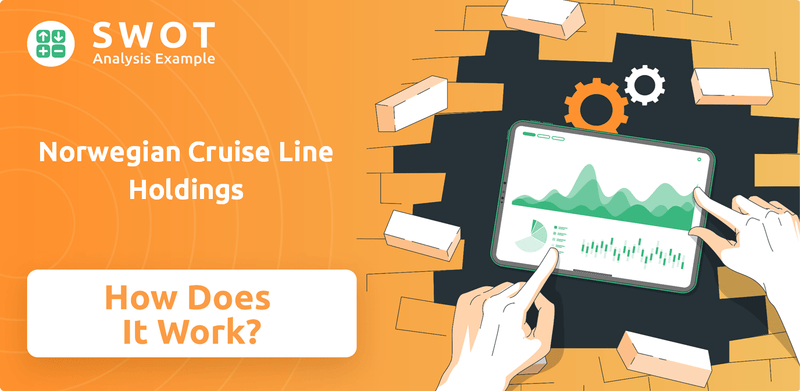
This exploration of NCL Holdings delves into the core of its cruise ship business, examining how it generates revenue and adapts to market changes. We'll investigate the company's strategic decisions, from fleet expansion and destination choices to onboard offerings, all of which impact its financial performance. Whether you're interested in NCL stock, the cruise line industry, or simply curious about how a major company operates, this analysis offers valuable insights into Norwegian Cruise Line's inner workings.
What Are the Key Operations Driving Norwegian Cruise Line Holdings’s Success?
Norwegian Cruise Line Holdings Ltd. (NCLH) creates value by offering varied cruise experiences through its three brands: Norwegian Cruise Line, Oceania Cruises, and Regent Seven Seas Cruises. Each brand targets different customer segments, ensuring a broad market reach within the cruise line industry. This multi-brand strategy is a core component of the company's operational and value proposition.
The operational framework of NCLH involves intricate processes, from ship design and construction to itinerary planning and shore excursions. Its global supply chain sources provisions and fuel, supporting worldwide operations. Strategic partnerships and distribution networks, including direct sales and travel agencies, are crucial for customer reach and satisfaction. Understanding the cruise ship business model is key to appreciating how NCLH functions.
NCLH's core strategy is built upon providing diverse cruise experiences. Norwegian Cruise Line offers 'Freestyle Cruising,' appealing to a broad demographic. Oceania Cruises provides premium experiences focused on culinary excellence. Regent Seven Seas Cruises defines ultra-luxury cruising. This diversified approach allows NCLH to cater to a wide range of preferences and budgets, enhancing customer satisfaction and loyalty. To learn more about the company's growth strategy, consider reading about the Growth Strategy of Norwegian Cruise Line Holdings.
NCLH's fleet includes various cruise ships across its brands. As of 2024, the company operates a significant number of vessels, with plans for further expansion. The fleet's size and composition are crucial for its operational capacity and market reach. NCL cruise ship fleet details are essential for understanding the scope of the company's operations.
Itinerary planning is a critical aspect of NCLH's operations. The company offers cruises to various destinations worldwide, including the Caribbean, Europe, and Alaska. The selection of destinations and the creation of unique itineraries are vital for attracting customers and differentiating its offerings. Where does Norwegian Cruise Line operate cruises is a key question for potential travelers.
Customer service plays a vital role in the success of NCLH. The company focuses on providing excellent service to enhance customer satisfaction and loyalty. How does NCL handle customer service is a crucial factor in its reputation and ability to retain customers. Addressing customer needs is fundamental to NCLH's value proposition.
NCLH's financial performance is a key indicator of its success. The company's revenue, profitability, and financial health are closely monitored by investors and analysts. Understanding Norwegian Cruise Line financial performance is essential for assessing the company's long-term viability and investment potential. The company's financial data can be found in NCL Holdings annual reports.
NCLH's value proposition is driven by its diverse brand portfolio, operational efficiency, and customer-centric approach. The company aims to provide unique cruise experiences that cater to different segments of the market. This strategy is supported by robust operational capabilities and a focus on customer satisfaction.
- Multi-brand strategy allows NCLH to capture a wider market.
- Operational efficiency through economies of scale in procurement and marketing.
- Customer satisfaction through varied cruise experiences and flexible options.
- Strategic partnerships to ensure seamless operations and diverse offerings.
Norwegian Cruise Line Holdings SWOT Analysis
- Complete SWOT Breakdown
- Fully Customizable
- Editable in Excel & Word
- Professional Formatting
- Investor-Ready Format
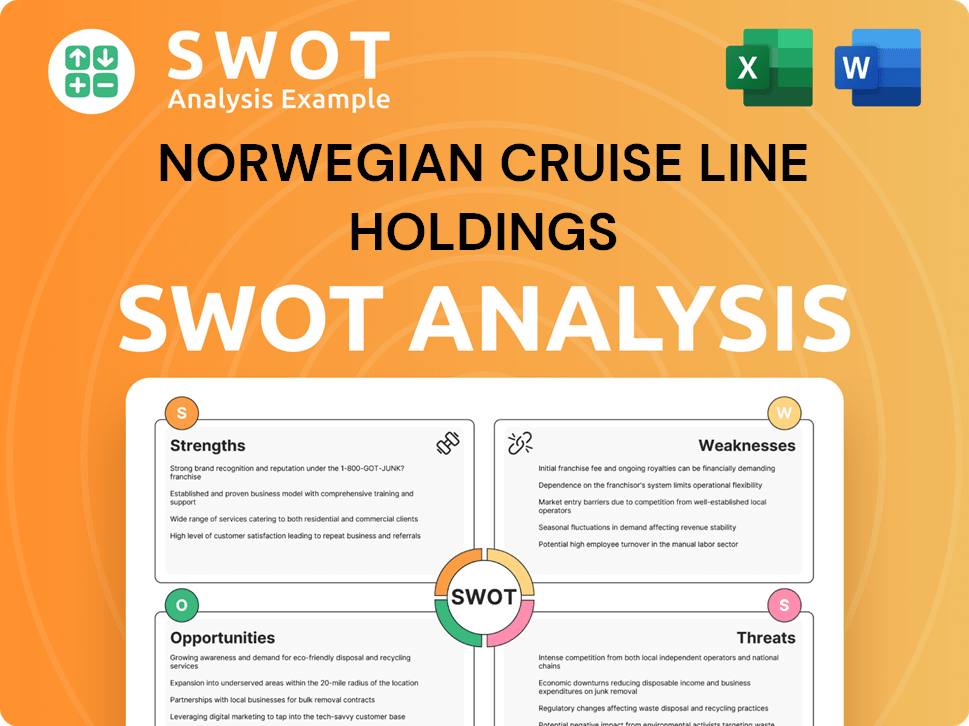
How Does Norwegian Cruise Line Holdings Make Money?
Understanding the revenue streams and monetization strategies of Norwegian Cruise Line Holdings is key to grasping its financial performance. The company, known for its cruise ship business, generates income primarily from ticket sales and onboard revenue. These strategies are crucial in the cruise line industry, influencing both top-line growth and profitability.
Ticket sales form the bulk of the revenue, covering cruise fares and associated costs. Onboard and other revenue, encompassing services and products purchased on the ship, adds significantly to the financial picture. In 2023, NCLH reported approximately $8.55 billion in total revenue, indicating a robust operation.
The company anticipates a strong 2024. Net yields are expected to increase by about 13.6% compared to 2023, with adjusted EBITDA projected to reach roughly $2.25 billion. These projections highlight the effectiveness of NCLH's revenue-generating strategies.
NCLH employs several monetization strategies to boost revenue. These include tiered pricing, dynamic pricing models, and cross-selling techniques. The company focuses on maximizing onboard spending to increase per-guest revenue.
- Tiered Pricing: Different cabin categories and packages offer varied amenities.
- Freestyle Choice: Programs like this allow guests to select value-added benefits.
- Dynamic Pricing: Fares are adjusted based on demand and booking windows.
- Cross-selling: Promotions for specialty restaurants and shore excursions are common.
- Onboard Revenue: Net per diem yields in Q1 2024 exceeded 2019 levels, showing success in encouraging guest spending. For example, Norwegian Cruise Line, Oceania Cruises, and Regent Seven Seas Cruises saw increases of 29.1%, 42.6%, and 31.9%, respectively.
Norwegian Cruise Line Holdings PESTLE Analysis
- Covers All 6 PESTLE Categories
- No Research Needed – Save Hours of Work
- Built by Experts, Trusted by Consultants
- Instant Download, Ready to Use
- 100% Editable, Fully Customizable
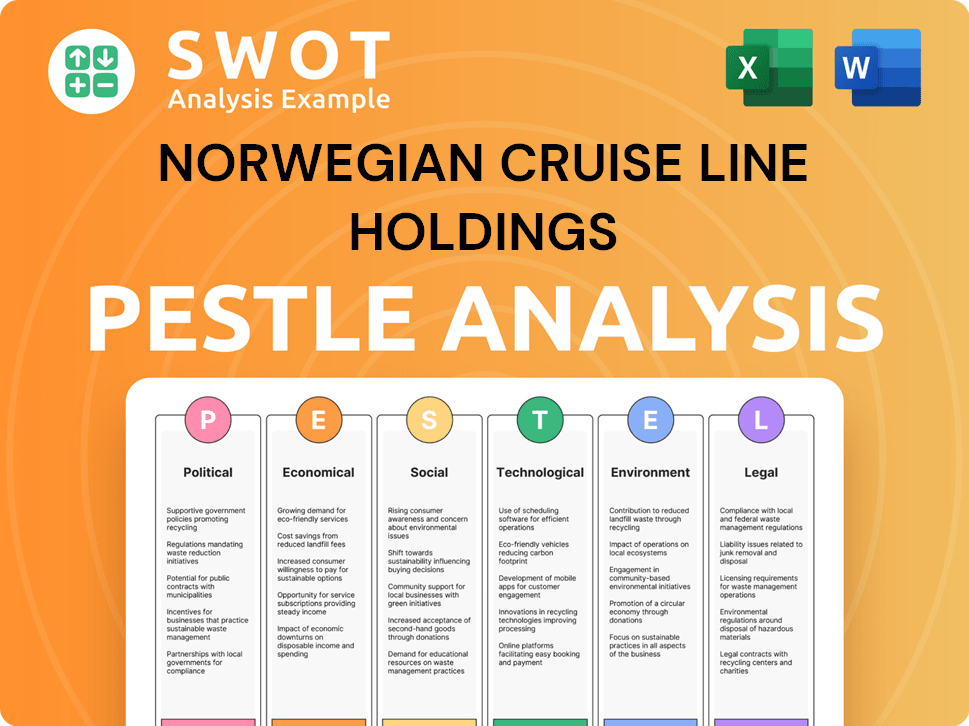
Which Strategic Decisions Have Shaped Norwegian Cruise Line Holdings’s Business Model?
The journey of Norwegian Cruise Line Holdings Ltd. (NCLH) has been marked by significant milestones and strategic shifts, shaping its position in the cruise line industry. A key move was the acquisition of Oceania Cruises and Regent Seven Seas Cruises in 2014, which expanded its market reach into the upper-premium and luxury segments. This diversification allowed NCLH to cater to a wider range of customer preferences and price points, enhancing its overall market competitiveness.
NCLH's strategic focus on fleet modernization and capacity expansion is evident through the introduction of new, advanced ships. The ongoing investment in new vessels, such as the Prima Class for Norwegian Cruise Line and the Allura Class for Oceania Cruises, reflects its commitment to providing contemporary cruise experiences. The delivery of the Norwegian Aqua in 2025 and the Allura Class ship for Oceania Cruises in 2025 are prime examples of this strategic initiative. These new ships are designed to enhance guest experiences and improve operational efficiency.
The cruise ship business faced unprecedented challenges during the COVID-19 pandemic, with operations completely shutting down. NCLH responded by implementing stringent health and safety protocols upon the resumption of cruising and focusing on managing its liquidity. The company's ability to adapt and navigate these challenges highlights its resilience and strategic agility, crucial for long-term success in the dynamic cruise line industry. For a deeper understanding of the company's target audience, explore the Target Market of Norwegian Cruise Line Holdings.
The acquisition of Oceania Cruises and Regent Seven Seas Cruises in 2014 significantly diversified NCLH's brand portfolio. The introduction of new ship classes, such as the Prima Class and Allura Class, demonstrates a commitment to fleet modernization. Addressing the challenges of the COVID-19 pandemic with health protocols and liquidity management was crucial.
Fleet expansion and modernization are ongoing strategic priorities for NCLH. Emphasis on health and safety protocols post-pandemic reflects adaptability. The company is focusing on enhancing guest experiences. NCLH is investing in environmentally friendly technologies.
Strong brand recognition across its three distinct brands allows NCLH to appeal to a wide array of travelers. Economies of scale in purchasing, marketing, and shared administrative functions provide a significant advantage. The 'Freestyle Cruising' concept for Norwegian Cruise Line offers a unique value proposition. NCLH's adaptability to market trends and commitment to guest experiences are crucial.
Continued fleet expansion with new ship deliveries in 2025. Further development of new itineraries to meet the growing demand for experiential travel. Investment in sustainable technologies to reduce environmental impact. Focus on delivering exceptional guest experiences and adapting to market changes.
NCLH's competitive advantages include strong brand recognition and economies of scale. The company's 'Freestyle Cruising' concept provides a unique selling point. NCLH is adapting to new trends and investing in environmentally friendly technologies.
- Brand recognition across three distinct brands.
- Economies of scale in purchasing and marketing.
- 'Freestyle Cruising' concept for Norwegian Cruise Line.
- Investment in sustainable technologies.
Norwegian Cruise Line Holdings Business Model Canvas
- Complete 9-Block Business Model Canvas
- Effortlessly Communicate Your Business Strategy
- Investor-Ready BMC Format
- 100% Editable and Customizable
- Clear and Structured Layout
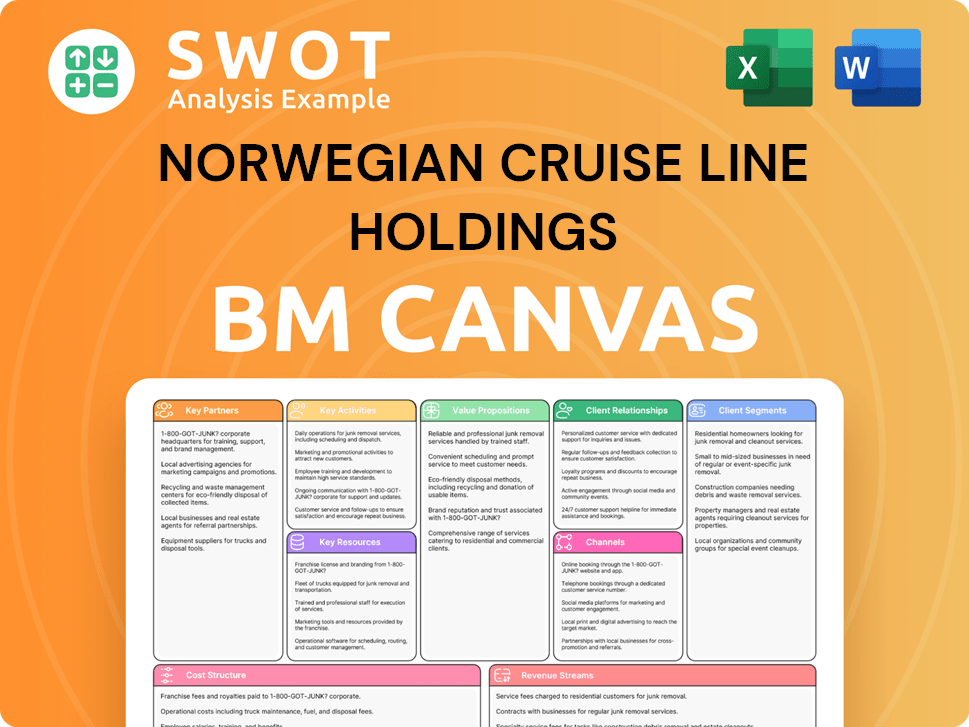
How Is Norwegian Cruise Line Holdings Positioning Itself for Continued Success?
Norwegian Cruise Line Holdings Ltd. (NCLH) is a major player in the cruise line industry, operating under several brands that cater to diverse market segments. The company competes with industry giants like Carnival Corporation and Royal Caribbean Group. Its operations span globally, offering cruises to various destinations worldwide, which helps to solidify its market position.
NCLH's business model includes a multi-brand strategy, allowing it to capture a wide range of customers, from contemporary to luxury travelers. This approach, along with its customer loyalty programs, helps foster repeat bookings and strengthens its market presence. The company's focus on fleet expansion and yield management further supports its revenue generation and market competitiveness. For those interested in the financial aspects, understanding the competitive landscape of Norwegian Cruise Line Holdings can provide additional insights.
NCLH holds a significant position within the global cruise industry. Its multi-brand strategy allows it to capture a large market share across different segments. The company's global reach, with itineraries spanning all continents, further solidifies its market presence. NCLH's focus on customer loyalty programs encourages repeat bookings.
NCLH faces risks like geopolitical instability, which can disrupt itineraries. Economic downturns may reduce discretionary spending on leisure travel. Fluctuating fuel prices pose a significant operational cost. Regulatory changes and the emergence of new competitors also present challenges. Adverse publicity can impact brand reputation and bookings.
NCLH is focused on strategic initiatives to sustain and expand its revenue. This includes fleet modernization and expansion, with new ships planned for delivery in 2025. The company emphasizes yield management and increasing onboard revenue. Leadership aims to maximize shareholder value through capital allocation and operational efficiency.
NCLH expects to achieve record financial results in 2024. Adjusted EBITDA is projected to be approximately $2.25 billion. Strong demand for cruising and a focus on delivering premium experiences are expected to drive continued growth. The company's investments in new ships and enhanced guest experiences are key to its financial strategy.
NCLH's strategic initiatives are designed to boost its financial performance and market position. These include fleet modernization and expansion, with new ships being delivered. The company is also focusing on yield management and increasing onboard revenue.
- Fleet modernization and expansion, including new ships like the Norwegian Aqua and Allura Class vessel for Oceania Cruises.
- Emphasis on yield management to maximize revenue from existing capacity.
- Focus on enhancing guest experiences and personalized offerings to drive onboard spending.
- Disciplined capital allocation and operational efficiency to maximize shareholder value.
Norwegian Cruise Line Holdings Porter's Five Forces Analysis
- Covers All 5 Competitive Forces in Detail
- Structured for Consultants, Students, and Founders
- 100% Editable in Microsoft Word & Excel
- Instant Digital Download – Use Immediately
- Compatible with Mac & PC – Fully Unlocked
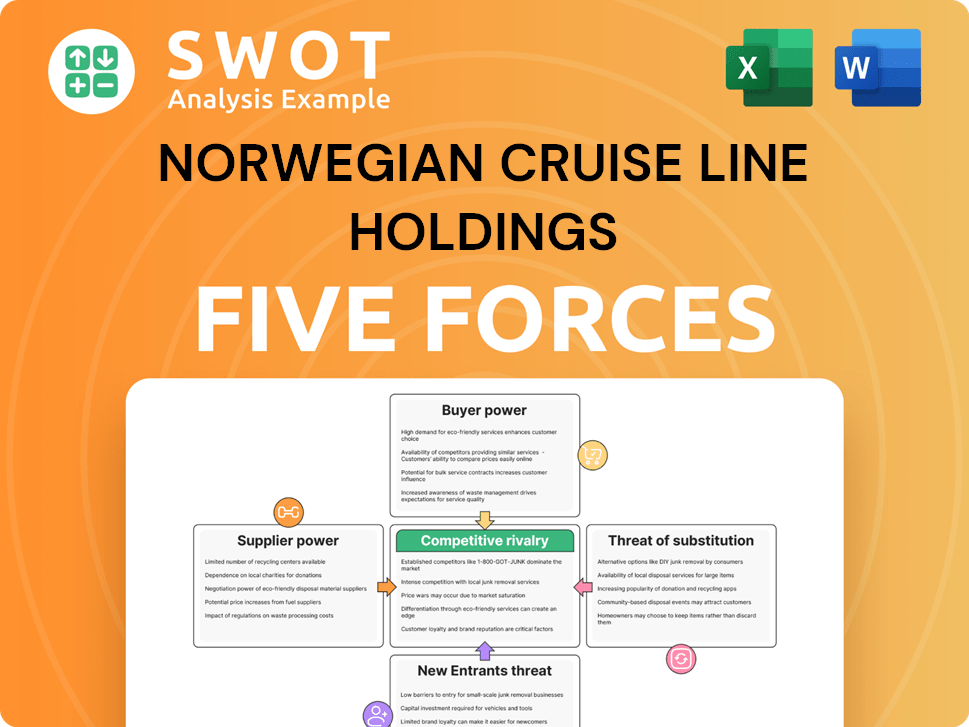
Related Blogs
- What are Mission Vision & Core Values of Norwegian Cruise Line Holdings Company?
- What is Competitive Landscape of Norwegian Cruise Line Holdings Company?
- What is Growth Strategy and Future Prospects of Norwegian Cruise Line Holdings Company?
- What is Sales and Marketing Strategy of Norwegian Cruise Line Holdings Company?
- What is Brief History of Norwegian Cruise Line Holdings Company?
- Who Owns Norwegian Cruise Line Holdings Company?
- What is Customer Demographics and Target Market of Norwegian Cruise Line Holdings Company?
Disclaimer
All information, articles, and product details provided on this website are for general informational and educational purposes only. We do not claim any ownership over, nor do we intend to infringe upon, any trademarks, copyrights, logos, brand names, or other intellectual property mentioned or depicted on this site. Such intellectual property remains the property of its respective owners, and any references here are made solely for identification or informational purposes, without implying any affiliation, endorsement, or partnership.
We make no representations or warranties, express or implied, regarding the accuracy, completeness, or suitability of any content or products presented. Nothing on this website should be construed as legal, tax, investment, financial, medical, or other professional advice. In addition, no part of this site—including articles or product references—constitutes a solicitation, recommendation, endorsement, advertisement, or offer to buy or sell any securities, franchises, or other financial instruments, particularly in jurisdictions where such activity would be unlawful.
All content is of a general nature and may not address the specific circumstances of any individual or entity. It is not a substitute for professional advice or services. Any actions you take based on the information provided here are strictly at your own risk. You accept full responsibility for any decisions or outcomes arising from your use of this website and agree to release us from any liability in connection with your use of, or reliance upon, the content or products found herein.